
Illustration of tree, cones, seeds, and foliage [Matt Strieby, 2020].
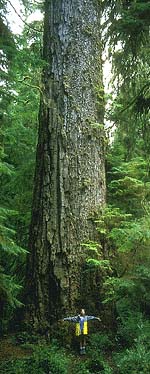
The Queets fir, for over 50 years one of the largest known Douglas-firs [C.J. Earle].
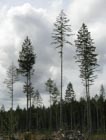
The leave trees in this recent clearcut show the typical architecture of mature P. menziesii when grown in a closed-canopy, even-aged stand. Note the shallow live crown and absence of epicormic branches [C.J. Earle, 2009.05.03].
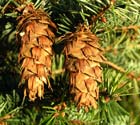
Mature cones, Ebey's Landing, Washington [C.J. Earle, 2005.12.10].

Closeup of the underside of a sun foliage shoot, showing pollen cone buds and the manner of leaf attachment to the twig [C.J. Earle].
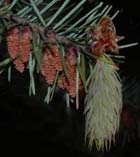
Immature seed cone and active pollen cones [C.J. Earle, 2002.05.04].

The old-growth stand at Hoypus Hill, Deception Pass State Park, Washington. Lowland stands in the Puget Trough were uniquely adapted to dry summers and relatively frequent fires, but were almost all harvested early in the historical period; this is the best surviving example of that forest type [C.J. Earle, 1987.08.02].

This stand in Washington's Wind River Experimental Forest, with its understory of vine maple (Acer circinatum), is an excellent example of the old Douglas-fir forests of the Cascade Mountains. Left undisturbed, it would succeed to Tsuga heterophylla dominance, but high severity fire at intervals of a few hundred years is sufficient to keep it in Pseudotsuga dominance [C.J. Earle, 1987.10.24].
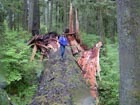
This exceptionally large tree near Lake Quinault, Washington was felled by Phaeolus schweinitzii, the fungus causing brown cubical butt rot [C.J. Earle, 2003.05.17].
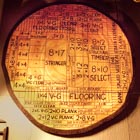
This cross-section displayed at the Seaport Museum in Raymond, Washington shows how an old-growth log harvested in the 20th Century might typically be cut to render commercial timber [C.J. Earle, 2008.07.25].

Conservation Status

Pseudotsuga menziesii subsp. menziesii
Common names
Coast Douglas-fir, Douglas-fir (Lipscomb 1993).
Taxonomic notes
Both subspecies of Ps. menziesii are sometimes treated as varieties. I prefer the subspecies rank because they are clearly distinct in ways that include morphology, distribution, and ecology.
Description
Trees to 90(100) m; trunk to 440 cm diam. Leaves dark green to yellowish green. Seed cones 6-10 cm; bracts straight, appressed. 2n=26 (Lipscomb 1993). Practically, the main distinction between this and subsp. glauca, apart from the glaucous foliage on the eastern trees, is that mature, dry cones of subsp. menziesii have appressed bracts, while those on var. glauca are reflexed, except in Mexico, where they are often straight (but subsp. menziesii doesn't occur in Mexico).
Distribution and Ecology
Canada: British Columbia; USA: Washington, Oregon, Nevada, California; at 0-2300 m elevation. The elevation distribution rises from north to south, covering 0-760 m in central British Columbia, 0-1250 m on Vancouver Island, 0-1520 m in Washington and Oregon, 610-1830 in southern Oregon and the Sierra Nevada, and on up to 2300 m near its range limits in the southern Sierra. In the Sierra, it may also occur much lower (240 m) in valley bottoms receiving cold air drainage from mountainsides (Burns & Honkala 1990).
Var menziesii grows under a wide variety of climatic conditions, as shown in the following Table. Generally, it experiences a maritime climate with mild, wet winters, cool, relatively dry summers, a long frost-free season, and a narrow daily temperature range of about 6-8° C. Climate in the Cascade Range and Sierra Nevada tends to be slightly more severe: winters are colder, frost-free seasons are shorter, and diurnal fluctuations of temperature are larger (10-16°C). Much of the precipitation falls as snow (Burns and Honkala 1990).
| Region | Mean temperature (°C) | Frost-free
period
(days) | Mean precipitation |
| July | January | Annual (mm) | Snowfall (cm) |
| Pacific Northwest Coastal | 20 to 21 | 2 to 3 | 195 to 260 | 760 to 3400 | 0 to 60 |
| Cascades and Sierra Nevada | 22 to 30 | -9 to 3 | 80 to 180 | 610 to 3050 | 10 to 300 |
| Source: Burns and Honkala (1990). |
| | | | | | |
Var. menziesii grows best on well-aerated, deep soils with a pH of 5 to 6. Soils in the coastal belt of northern California, Oregon, and Washington originated chiefly from marine sandstones and shales with scattered igneous intrusions. These rocks have weathered deeply to fine-textured, well-drained soils under the mild, humid climate of the coast. Surface soils are generally acid, high in organic matter and total nitrogen, and low in base saturation. Soils in the Puget Sound area and in southwestern British Columbia are almost entirely of glacial origin. Soils farther inland within the range of the variety menziesii are derived from a wide variety of parent materials. These include metamorphosed sedimentary material in the northern Cascades and igneous rocks and formations of volcanic origin in the southern Cascades. Limestone is a relatively rare parent material, however. Soil depth ranges from very shallow on steep slopes and ridgetops to deep in deposits of volcanic origin and residual and colluvial materials. Texture varies from gravelly sands to clays. Organic matter content varies from moderate in the Cascade Range to high in portions of the Coast Range and Olympic Peninsula; since the species usually regenerates after fire, though, it predominantly establishes on mineral soils with very low organic content. Total nitrogen content varies considerably but is usually low. Great soil groups characteristic of the range of coastal Douglas-fir include Haplohumults (Reddish Brown Lateritics) of the order Ultisols, Dystrochrepts (Brown Lateritics), Haplumbrepts (Sols Bruns Acides) of the order Inceptisols, Haplorthods (Western Brown Forest soils) of the order Spodosols, Xerumhrepts (Brown Podzolic soils), and Vitrandepts (Regosols) (Burns and Honkala 1990).
Douglas-fir forms nearly pure stands over very large areas from a northern limit on Vancouver Island through western Washington, Oregon, and the Klamath and Coast Ranges of northern California as far as the Santa Cruz Mountains. In the Sierra Nevada, Douglas-fir is a common part of the mixed conifer forest as far south as the Yosemite.
The dominance of this one species over such large areas was largely due to the periodic recurrence of catastrophic wildfires, which tended to be larger and less frequent in the more northerly limits of its range. On Vancouver Island and coastal British Columbia such fires had recurrence intervals on the order of millennia, with the result that the species' dominance there is limited by its exclusion from the old forest (which usually came to be dominated by a mix of Tsuga heterophylla, Picea sitchensis and Thuja plicata); it is basically an early successional species that is able to live as long as a millennium as a canopy dominant, but that cannot regenerate under a forest canopy. In western Washington, Douglas-fir found ideal conditions with catastrophic fires having recurrence intervals of a few hundred years; some such fires recorded early in the historical period burned over areas of nearly a million hectares, with new cohorts of var. menziesii springing up in the aftermath to dominate forests that often also included Thuja plicata, with Tsuga heterophylla codominant on interior sites and Picea sitchensis codominant on sites near the coast. From Oregon southward, the fire frequency increases to decadal scales, with the result that the landscape is a patchwork of differently aged forests, with many fires having relatively low intensity, and in this environment the vast pure stands of Douglas-fir begin to give way to mixed forest stands where var. menziesii shares dominance with other large, long-lived, generally fire-tolerant species including Pinus lambertiana, Pinus monticola, Pinus ponderosa, Calocedrus decurrens, and several species of Abies (from north to south: Abies grandis, Abies procera, Abies magnifica, and Abies concolor var. lowiana). It also grows with quite a variety of other western conifers, albeit in more restricted settings; for example, some of the largest recorded Douglas-firs grow in close association with groves of Sequoia sempervirens, and at the alpine timberline, it can be found with species such as Tsuga mertensiana. Although logging has largely eliminated the original old-growth forest except in a few preserves, clearcutting combined with slash burning and planting has helped maintain Douglas-fir as the major component in second-growth stands. Where regeneration of Douglas-fir was only partially successful or failed, red alder (Alnus rubra) and often bigleaf maple (Acer macrophyllum) has become an associate of Douglas-fir or has replaced it altogether (pers. obs. 1975-2015).
"The most important shrubs associated with coastal Douglas-fir through its central and northern range are vine maple (Acer circinatum), salal (Gaultheria shallon), Pacific rhododendron (Rhododendron macrophyllum), Oregon grape (Berberis nervosa), red huckleberry (Vaccinium parvifolium), and salmonberry (Rubus spectabilis). Toward the drier southern end of its range, common shrub associates are California hazel (Corylus cornuta var. californica), oceanspray (Holodiscus discolor), creeping snowberry (Symphoricarpos mollis), western poison-oak (Toxicodendron diversilobum), ceanothus (Ceanothus spp.), and manzanita (Arctostaphylos spp.)" (Burns and Honkala 1990).
See P. menziesii for remarks on the use of Douglas-fir outside its native range. Almost all such use is of subsp. menziesii.
Remarkable Specimens
The largest volume tree is the Red Creek Fir, about 18 km by road from Port Renfrew on Vancouver Island, British Columbia. The tree is widely known and directions for locating it are available in Port Renfrew. In December 1998 I visited this tree with Dr. Robert Van Pelt and we collected precise measurements in research for his book (Van Pelt 2001). In 1998 it was measured as having a height of 73.8 m, dbh of 423 cm, and crown spread of 23 m, for a total wood volume of 349 m3. This tree is the largest known individual in the family Pinaceae. Other exceptional specimens include:
- Measured March 1998, a tree near Lake Quinault in Olympic National Forest, WA, called Tichipawa (Van Pelt 2001). Its height is 85.6 m, dbh 408 cm, crown spread 22 m, and wood volume 308 cubic meters. The precise location has not been released, but this is a fine area to see enormous trees in general (e.g., the largest Picea sitchensis in the U.S. is nearby).
- The Queets Fir: Height 61 m, dbh 485 cm, in the Queets River valley of Olympic National Park, WA (Robert Van Pelt e-mail 2004.02.04). This tree, shown at right, has been known since about 1945 and for most of that time was regarded as the largest known Douglas-fir. It has grown smaller over that time due to the loss of its top and large branches and now all live foliage is restricted to a single very large branch. However, it retains the largest diameter of any known Douglas-fir. This tree is also widely known and easily reached by trail; directions are available from Olympic National Park ranger stations.
Historical records identify much larger and taller trees. Such records are always subject to question, but some were collected by professional foresters and scientists and are likely quite reliable. For example, a tree near Mineral, Washington was measured at 68.6 m (225 feet) tall in 1924, at which time its top, which had broken off many years before and was on the ground, was measured at 48.8 m (160 feet), indicating a total height of at least 117.3 m (385 feet). This tree was 469 cm (15.4 feet) dbh. It was blown down in 1930 and a section of it can be seen at the Wind River Arboretum in Carson, Washington (Carder 1995). The measurements were made by Richard McCardle and Leo Isaac, both highly qualified and widely published forest scientists of the day.
The tallest Douglas-firs have primarily been identified since about 2010 through review of LIDAR data, which have now been collected for essentially all U.S. sites where exceptionally tall trees may be expected. The tallest known specimens include one 99.2 m tall in Redwood National Park, California; one 99.5 m tall in Oregon; and one 97.3 m tall southwest of Mt. St. Helens in Washington (Michael Taylor e-mail 2022.04.18). There is an emerging pattern where the tallest individuals of Pinaceae species (Abies grandis, Picea sitchensis, Pseudotsuga menziesii and Tsuga heterophylla) are all located in forests dominated by even taller trees of Sequoia. Apart from these examples, though, the main areas of very tall Douglas-firs include the central Oregon coast range (34 trees over 95 m tall) and Olympic National Park in Washington (8 trees over 95 m tall).
This is another species that loves New Zealand (home to the largest known trees of several conifers native to other countries). The oldest plantings of the species in that country, at Peel Forest Estate, date to 1859 and include a specimen that was 69.6 m tall in late 2013 (Robert Van Pelt email 2013.12.26). It is possible that one day New Zealand may host larger Douglas-firs than North America; an analysis by Waring et al. (2008) showed that the tree attains higher growth rates there than it does in North America, basically because of greater growing-season precipitation that reduces water stress, enabling higher net primary productivity.
There are relatively abundant data on very old trees. There was a ring-counted age of 1350 years for a specimen from Vancouver Island (BC) collected by M.L. Parker and Les Jozsa (Brown 1996). This tree was one member of stand that established after a fire ca. 635 A.D. It blew down in a storm in the winter of 1985-86, providing an opportunity to date it (Stoltmann 1987). It is plausible that older trees are still alive in the stand. There is also a record of 1307 years for a stump in a clearcut on Waterloo Mtn, Vancouver Island, sampled by Les Jozsa (Stoltmann 1993). Ages of 650 years are fairly common in western Washington and British Columbia, whereas trees more than 800 years old are quite rare and no living trees have been demonstrated to be as much as 1000 years old; all evidence is from the stumps of cut trees.
Ethnobotany
Within its home range, native peoples preferred it for fuel and also used its wood for diverse implements, including harpoon shafts and barbs, spoons and caskets. Its pitch was used for sealing joints and as a caulk for canoes and water vessels, and was also used as a medicinal salve for wounds (Pojar and Mackinnon 1994).
This was the preferred species for Hawaiian war canoes. The Hawaiians, of course, did not log the trees; they had to rely on driftwood. It was also used by the Hawaiians and other Polynesian for bowls, paddles, and sundry other implements.
Much of the Pacific Northwest was settled primarily for the purpose of logging vast forests of giant Douglas-fir trees, which dominated portions of the landscape, such as the western Cascade Range, prone to severe but infrequent wildfire. At that time it was used primarily for construction, and many of the older houses in western Washington contain no other wood except for cedar (Thuja plicata) siding and shingles. It continues to be the preferred timber species in the region.
The world's largest wooden buildings, two blimp hangars, were built of Douglas-fir at Tillamook Naval Air Station in Oregon, in 1943. One of these burned in 1993 but the other is now the home of the Tillamook Air Museum and is open to the public. The hangar is 327 m long, 90 m wide, and 59 m tall - big enough to comfortably hold the Todaji Temple in Nara, Japan, which is often called the world's largest wooden building.
The old-growth forests of western Washington, Oregon, and northern California (in that area, the term "old growth" predominately covers forests dominated by coastal Douglas-fir) were the site of a major environmental battle in the 1980s and 1990s. Logging of these forests reached its all-time high in 1983, but at the same time an environmentalist groundswell was developing to provide these rapidly vanishing forests with meaningful, lasting protection. The mechanism to achieve this came in the form of two endangered bird species, the marbled murrelet (Brachyramphus marmorata) and the northern spotted owl (Strix occidentalis varia). After protracted legal disputes, these birds received protection under the Endangered Species Act in 1990 (for the owl) and 1992 (for the murrelet), and in response the environmental community launched a battery of legal challenges that effectively stopped logging of old-growth forests within the range of these two birds. Although subsequent management actions have allowed some old forests to be logged since that time, the preserves established for owl and murrelet protection continue to protect some of the finest forests in the region. Both birds continue to decline, however, and there remains a risk of renewed exploitation of these forests if and when their existing legal protections are weakened by ongoing efforts to open these lands again to exploitation. The form of that exploitation became apparent during the Trump administration in the U.S. (2016 to 2020), at which time large acreages of previously unlogged forests in the region were put up for timber sale. These were generally forests that in the 1980's and 1990's were too young to be classified as old-growth, but that have now acquired the ecological and economic attributes of old-growth.
This is an important species for dendrochronology. Numerous collections have been made to study topics as diverse as stand age structure, stand dynamics, air pollution impacts on tree growth, and climate change.
Observations
The largest trees and most impressive forests are found within 200 km of the Pacific Ocean. Some of the most spectacular stands are to be found in Olympic National Park and Mt. Rainier National Park (Washington), but scores if not hundreds of other extraordinary stands still remain in California, Oregon, Washington and British Columbia. For example, many of the famous redwood (Sequoia sempervirens) groves are also home to very large and tall Douglas-firs. Stoltmann (1987, 1993) provides descriptions and directions for visiting many of the Pacific Northwest stands. Nearly all of these are montane stands. Far larger trees were once widespread at low elevations on Vancouver Island and throughout the Puget-Willamette Trough, but virtually all have been logged. Remnant low-elevation stands can still be found in Millersylvania State Park (Washington), Deception Pass State Park (Washington), Seward Park (Seattle, Washington), Lighthouse Park (near Vancouver, British Columbia), in the Port Renfrew area of British Columbia, and probably other areas on Vancouver Island.
Remarks
Douglas-fir is the state tree of Oregon.
Citations
Carder, Al. 1995. Forest Giants of the World. Fitzhenry and Whiteside, 208pp.
Waring, Richard, Alan Nordmeyer, David Whitehead, et al. 2008. Why is the productivity of Douglas-fir higher in New Zealand than in its native range in the Pacific Northwest, USA? Forest Ecology and Management 255(12): 4040–4046.
See also
The Cathedral Grove, accessed 2009.04.01. Web site describes the destructive logging practices affecting one of the finest stands of big Douglas-fir in Canada.
Williams, Ted. 2009. Owl War II. Audubon, January-February. http://archive.audubonmagazine.org/incite/incite0901.html, accessed 2015.01.23, now defunct. A good summary of the controversy about spotted owls and old-growth forests.










